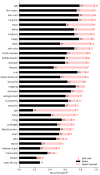Deep models of superficial face judgments
- PMID: 35446619
- PMCID: PMC9169911
- DOI: 10.1073/pnas.2115228119
Deep models of superficial face judgments
Abstract
The diversity of human faces and the contexts in which they appear gives rise to an expansive stimulus space over which people infer psychological traits (e.g., trustworthiness or alertness) and other attributes (e.g., age or adiposity). Machine learning methods, in particular deep neural networks, provide expressive feature representations of face stimuli, but the correspondence between these representations and various human attribute inferences is difficult to determine because the former are high-dimensional vectors produced via black-box optimization algorithms. Here we combine deep generative image models with over 1 million judgments to model inferences of more than 30 attributes over a comprehensive latent face space. The predictive accuracy of our model approaches human interrater reliability, which simulations suggest would not have been possible with fewer faces, fewer judgments, or lower-dimensional feature representations. Our model can be used to predict and manipulate inferences with respect to arbitrary face photographs or to generate synthetic photorealistic face stimuli that evoke impressions tuned along the modeled attributes.
Keywords: computational models; face perception; social traits.
Conflict of interest statement
Competing interest statement: All authors are listed as inventors on a related patent (US Patent no. 11,250,245, “Data-driven, photorealistic social face-trait encoding, prediction, and manipulation using deep neural networks”).
Figures




References
-
- Sutherland C. A., et al. ., Social inferences from faces: Ambient images generate a three-dimensional model. Cognition 127, 105–118 (2013). - PubMed
Publication types
MeSH terms
LinkOut - more resources
Full Text Sources

